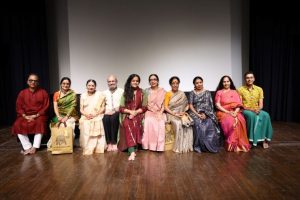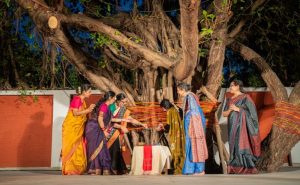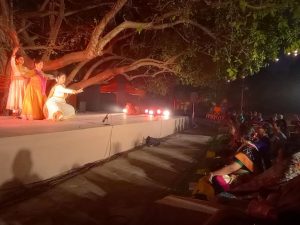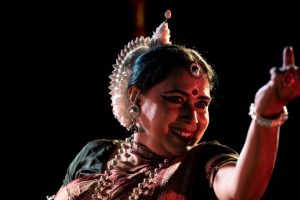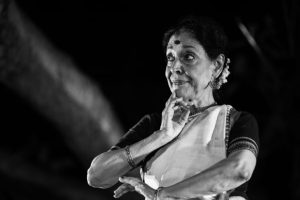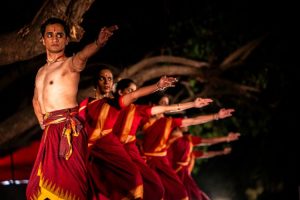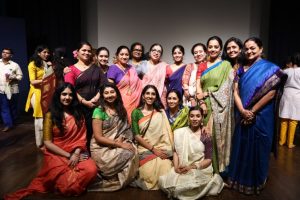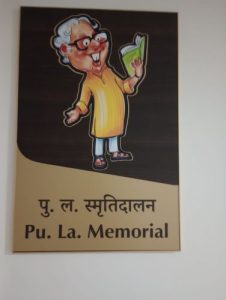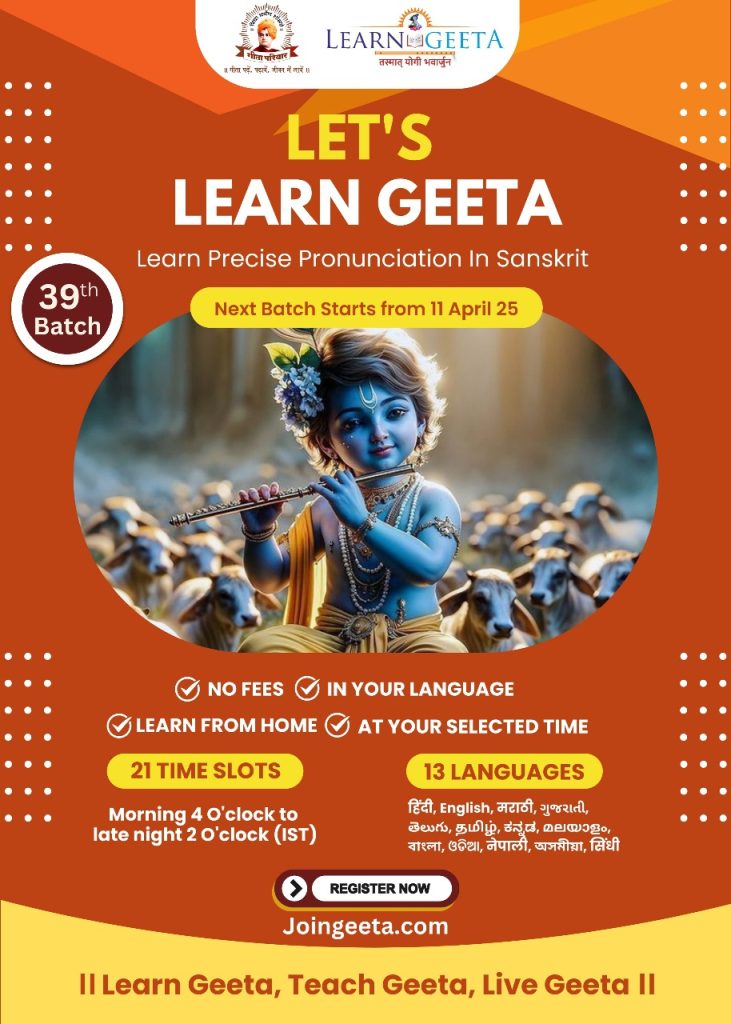DM: Echoes…
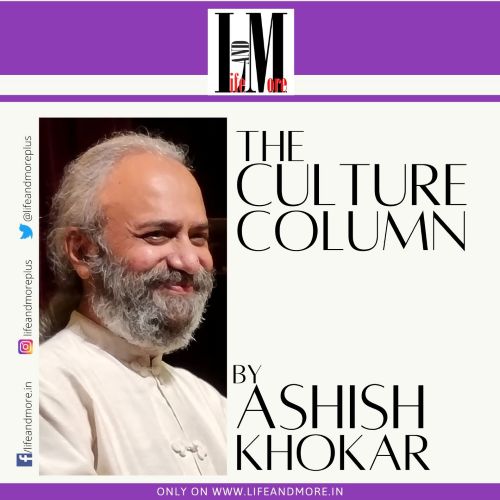
The word echo implies a sound that’s repeated when sent back from a surface it touches… an amplification if in the mountains; a ripple effect if by the sea and a voice from the past into the future if under a tree! Seven such voices assembled in Mumbai under a magical Banyan tree for senior Odissi guru-choreographer Daksha Mashruwala’s Kaishiki (Nrityabhasha banner), to create a unique synergy over a weekend on 15/16 November. Dubbed the Echoes of Tradition, it was a coming together of young and the seniors of India in the dance world. The seven main protagonists were: Gurus Daksha Mashruwala herself (though in the background and self-effacing; true pedigree shows in small things), Madhavi Mudgal, Uma Dogra, Aruna Mohanty, Mandakini Trivedi, Ratikant Mohapatra and Vaibhav Arekar.
What does Bombay have to offer in Indian dance? It was once the capital of classical dance of India and Delhi was just a village. In the 1960s and early 1970s. Today, it has some of that left in pockets, under the overarching influence of the film world and TV too. Still a few do-gooders and individuals and institutions have maintained traditions, the echo of which could be seen in this unique gathering of two days. Everything and more: old styles and new; mixes and misses! Veterans and wannabes. Since the region has no classical style of its own to boast of, it has taken in all. Bharatanatyam was first popularised by the Raja Rajeshwari School family. Then Kadirevellu and Acharya Parvati Kumar. Kathak had giants like icons Lachchu Maharaj, Damayanti Joshi, Sitara Devi, Roshan Kumari and so many gurus like Pt. Hazarilal, Gopi Krishna, Sudharshan Dheer, Pratap Pawar and all. Guru Bipin Singh made Bombay a home for Manipuri and gave India the Jhaveri sisters; Sachin Shankar, a cousin of Uday Shankar, gave contemporary works and Uttara Coorlawala gave it modern dance. Kuchipudi had Kamadeva. That Odissi has a centrestage today is thanks actually to Yamini Krishnamurthy. Yes! the doyenne of Bharatanatyam was the first in the 1960s to invite Adi Guru Pankaj Charan Das to come teach her when she was in Mumbai For two years before moving to Delhi for patronage (Read The Marg issue 1958 and the book The Dance Orissi by Mohan & Ashish Khokar, 2008, Abhinav). Seeing her example, Ritha Devi learnt Odissi too and then Indrani Rahman, later from Deba Prasad Das. Young India often doesn’t know all this because one, they are more on facebook than real books and two their teachers often don’t know enough to tell them the real history because their own may get marginalised.
Fast forward to the 1980s when the other Masters like guru Kelucharan Mohapatra started coming to teach in Bombay regularly and hold workshops where many new adherents were attracted to learn from them. Many Mumbaikars benefitted like Daksha Mashruwala, her neighbour in Beach House Co-Op building, Protima Bedi, Jhelum Paranjape, Rohini Dandavate, and so many… the current lot of seniors in the form are all from him in Odissi in Mumbai. Daksha Mashruwala also platformed three of these in this Festival: the senior-most guru Madhavi Mudgal, torch-bearer of the style, then the Master’s own son Ratikant Mohaptara, mardala player, teacher and choreographer with speed as his middle name! Star of the state-patronage of Odissi guru Aruna Mohanty – essentially a product of guru Gangadhar Pradhan, who learnt from all masters, so his style is an alloy of an alloy. Also featured were a senior of Kathak, Guru Uma Dogra, whose middle name ought to be smile! Buddha-like calm Mohiniakka, Mandakini Tri-devi, oops Trivedi! Add Vaibhav Arekar, who just kar kar...does, does dance here, there, everywhere. Each one was in top form and Bombay, err Mumbaikars welcomed them in the magical setting under an elmwood tree, almost. Bargad ke ped ki niche kuch ugta nahin lakin panapata zaroor! This institution – Sangit Mahabharati, set up by the renowned flute master Nikhil Ghosh babu in 1956 (his brother was equally illustrious Pannalal)…
This intro was to set the tone of how traditions continue and one innovates. That was the theme of the two-day learning process. Day one showcased the work of six thinking dancers: three in Odissi And one each in Bharatanatyam, Kathak and Mohiniattam. The term thinking always sets me thinking as though others are not but here it means they have gone beyond the routine.
Even the start was not routine or predictable: Daksha Mashruwala shared. Stringing anklet bells (ghungroos) and placing them on the stump of the huge tree was artistically done by two veterans present on the occasion: Gurus Darshana Jhaveri and Padma Sharma. Both, epitome of good grace.
The first to start the magical night under the Banyan tree was senior and ever smiling guru Uma Dogra. One has seen her from Delhi SBKK days, then under the umbrella of Pt Durgalal then shift to Bombay and set up school Samved there and create two landmark dance festivals – Raindrops (after monsoon of Mumbai, who needs more water but the founder Guru Uma being poetic and literary she means boond boond se nadi banne and nadi se sagar!) and one is in memory of Pt.
Durgalal FESTIVAL. Her well enunciated Ananda Shiva in Chautaal, composed by Sage Vasishth was effective and in the Ashtapadi Ratti Sukh saare... She had the right pace and her idea of innovation was instead of a thumri she undertook an ashtapadi. The open space didn’t lend itself for back rows to view subtle expressions of a senior properly but the refined material was there. Her ace shishyas, Sarita and Shiksha, were able to support and created good dynamics. Manoj Desai’s voice with Ashit Desai’s music made the depiction ring true.
Guru Aruna Mohanty next. She is an active dancer-organiser in Odisha, running a school creating good students. Senior most rep of guru Gangadhar Pradhan, she has worked hard to reach where she has but still looks like a college girl. Her work – Pratinayaka – a proto type of Nayaka focussed on not the opposite but parallel I’m therefore you are bit.
She took up the idea of four eras or yugas and characters and traits rep in each by say Narasimhan in Satyuga, done with effective lights, excellent chowkh and use of the tree behind on stage with her back to the audience, highlighting her strong postures. Rama Ravana rep Treta yuga (omitted for time constraints), Krishna Kamsa in Dwapar yuga and annihilation by Kali or Time itself in Kaliyuga. Aruna put her best and filled the stage with her solo act. To fill such a huge stage by one person is never easy but her strong artistry filled it like nobody else’s. Aruna has finally arrived for this long-time observor as a senior and shining rep of Odissi. She should leave group works alone and show solo as she has both the strength of material and substance to enhance. Add excellent music by Odisha’s ace talents Ramhari Das and Dhaneswar Swain and lights (by Tikki.) Text was based on the Bhagwat Puraan and the minute one heard the name of Kedar Mishra in credit for script, lyrics and concept one knew where Aruna’s depiction got its bone. Spine. A rich and powerful work. Kudos!
Senior Mohiniattam dancer-thinker-teacher guru Mandakini Trivedi used Hindi to innovate Mohiniattam. It is like having Samosa with Sambar! An excellent orator, her dance has an understated quality. Without the usual MohiniAkka hair accoutrements, the facial aharya looked empty. So does innovation also mean taking liberties with established norms of form like aharya or simplifying it? That’s a question too. Her Nateshwari Dance School is a hub for training adherents just as she trained under Gurus Kadirevellu in BN then Dr Kanak Rele in Mohiniattam. The story was the oft told story of Karna, born by boon of a mantra when Kunti sired a child by Sun – Suryadev – and how he was the eldest Pandava technically but discarded by Kunti in river Bhaghirathi and all the concomitant tale of Mahabharata. Music by BN guru CV Chandradrashekhar;lyrics based on Tagore’s Sambad translated by late Veena Alase was the bedrock.
Guru Madhavi Mudgal’s Pallavi was drawn from dhyaan from raga Jayjaywanti, music for which was composed by her brother Madhup Mudgal. Ah! it was so nice to hear some ghungroo sound!!! Only senior dancers sure of their art and work now use real ghungroos; youngsters are often today covering up their mistakes by wearing silent ones! In the next presentation – Kshnamadhuna – the tenderness of Krishna Radha companionship, Madhavi shared meaningfully.
Vaibhava Arekar is the new mascot of BN in Bombay. Trained under musicologist guru Saroja Srinath and later Kanak Rele, he has gone far beyond that mould to strike his own style, full of life, structure and aplomb. Taking Debotar Dash, a prose-poem of Tagore (Rabindranath not Sharmila!), he tried to look like a little boy in a red T-shirt and tell the story and on the whole enacted well. More dance-theatre with voiceover speech and all. Bengali Bharatanatyam? Is that innovation? Sticking to traditional fare next, in Greeshma , it showcased what a fine structure BN has and how well Vaibhav and his group have taken to it as if it is their second skin. Looking at his group work one could say he has alloyed the finesse of Kalakshetra with eclectics of Chandralekha and enhanced them both. Now, that’s an achievement. Sushant’s lights were a work of art, so well synchronised with each step. Brilliant!
Concluding presentation by senior Ratikant Mohapatra, Namami Gange was a boat on speed, in waters that were fast and in dancers that were first rate. The opening offering was Synthesis, with rhythm as its leitmotif. A master of mardala/ pakhawaj guru Ratikant is from young age as accompanist to his illustrious father too but this piece brought other instruments together under the command of Annada Prassanna Pattnaik and Satyabrata Katha. Devotion or Shraddha was the bedrock upon which the choreography of this sat. Namami gange! also touched on today’s realities it faces – pollution and worse. A grand time was had by all. To have an open stage and space in Mumbai is itself remarkable.
Kaishiki’s students duplicated as volunteers and what a selfless team it was of Namrata Mehta, Oolupi Shah, Siddhi Waikar, Saachi Jain, Sharanya Ghosh (what a voice; sakshaat Saraswati sits in her kantha), Prachi Mehta, Nandini Sethi, Neelam, Devpriya Bihani and more. They often didn’t eat on time in service of dance. So, it proves that for learning Indian classical dances GSP only can inculcate such a value system. Not really univs. There hardly anyone cares, all just want a degree. GSP means Guru Shishya Paramapara.
Next day at Pu.la. Deshpande Cultural complex took me on a nostalgia trip. Purshottam Laxman Deshpande was a theatre giant of Maharashtra but for us an “uncle” when in days of yore there were very few hotels in Delhi – the 1970s – he’d come for SNA meetings and stay with us as father then was the Secretary of the SNA. He was the VC. The bond was unique. In office, both were officious and at home both had a blast. Pula’s uncle laughed loudly (after all, he was a humorist first) and lived life long-sized. Best thing about him was, he never told father anything that we told him: I shared with him my low marks in math (he laughed it is saying you are going to be a cashier when you grow up, why worry? I told him I was weak in all science subjects. He said that you are good at English, Literature, Sanskrit, History and Geography. That was Pula uncle. Didn’t know then that he was such a popular man back home and Pune for us was a village those days when we were Delhi walas
PS: Since I, with star Kathakaar Gauri Sharma Tripathi, were moderators on stage with the sapta rishis making for us navarasa! it is best I don’t write about the Seminar proceedings. Those who attended can write in and add to our knowledge bank after reading this. Ethics and propriety dictate that. What’s that? someone may ask in today’s clime. Look up Google guru!
Saraswati has blessed Ashish Khokar totally for he has written 51 books, 5k articles in print media in the last 45 years (for the Times of India, The Hindu, First City, Life Positive, the India Magazine and India Today). He created 85 modules for the UGC e-pathshala MA Course. A pioneer in arts administration, he served the Delhi State Akademi, INTACH in the 1980s and worked internationally in France, Sweden, Germany and China in the 1990s. He is a visiting expert/professor to many universities abroad (Italy, Germany, USA, Malaysia and Mauritius). He taught special modules at MSU-Baroda, Flame in Pune, Punjab University Chandigarh, Bangalore and Mangalore universities. He has been bringing out India’s only yearbook on dance for the last 25 years – called attendance which is endorsed by UNESCO-CID as a model dance journal. He gives attendance awards to youngsters and seniors. Till date 40+ attenDance awards have been given. A list of 51 books and 40+ awardees can be seen on www.attendance-india.com. He is also the longest serving columnist for narthaki.com and India Today – contributing articles for 25 years now. Currently, he is the Chairman of NEEMRANA Dance Initiative and Curator of the Mohan Khokar Dance Collection & Archives@ IGNCA, Delhi. The India HABITAT centre and the IIC avail his expertise for special events and the world over, and he is treated as an authority on Indian dance. More details on www.attendance-india.com


